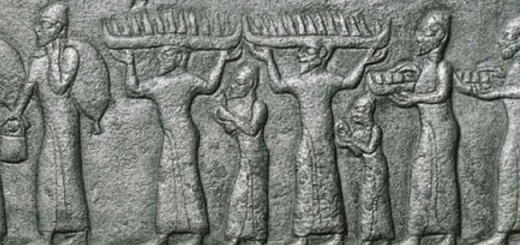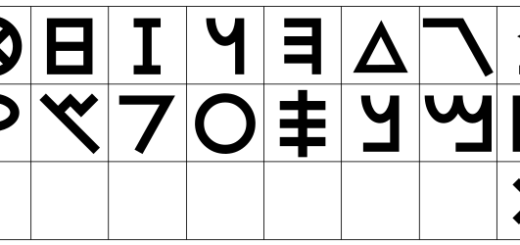Trading Activities in Ancient Phoenicia
Trade in the Phoenician World was a cornerstone of their civilization and a driving force behind their cultural and economic success. Renowned for their maritime prowess, the Phoenicians established a vast trade network that spanned the Mediterranean and beyond, from the Levant to North Africa, Europe, and the Atlantic coasts. Their role as intermediaries in trade, coupled with their innovative contributions to navigation, shipbuilding, and commerce, cemented their legacy as one of the most influential trading civilizations of antiquity.
The Phoenician Writing System & Language: Origin Story and Significance
Geographical and Cultural Context
The Phoenicians originated in the Levant, primarily in the region corresponding to modern-day Lebanon and parts of Syria and Israel. Their major city-states, including Tyre, Sidon, Byblos, and later Carthage, were strategically located along the Mediterranean coast, enabling easy access to sea routes.
Unlike unified empires, the Phoenician city-states were independent but connected through shared culture, language, and religion.
Their geography—flanked by mountains and the sea—pushed them toward maritime endeavors. With limited agricultural land and natural resources, trade became essential for their survival and prosperity.
READ MORE: Most Famous Phoenician Cities
Maritime Innovation and Shipbuilding
The Phoenicians were pioneers in shipbuilding and navigation. They developed advanced ship designs, such as the bireme, a sturdy and efficient vessel suited for long voyages. Their ships featured reinforced hulls and superior rigging systems, allowing them to traverse vast distances and endure harsh conditions at sea.
The Phoenician world revolved around trade, which was central to their identity, prosperity, and historical significance.
They were also among the first to use the North Star for navigation, enabling nighttime travel and enhancing the reliability of their trade expeditions. These advancements made Phoenician traders highly competitive and allowed them to dominate Mediterranean trade for centuries.
Trade Network and Routes

Phoenician trade networks (c. 1200–800 BC)
The Phoenician trade network was extensive, connecting diverse regions and facilitating the exchange of goods, ideas, and cultures.
The Levant served as a hub where goods from Mesopotamia, Egypt, and Anatolia converged. Phoenician merchants exported timber (notably cedar), glass, textiles, and purple dye, often referred to as “Tyrian purple,” which became a symbol of wealth and power.
The Phoenicians established colonies such as Carthage, which became a significant trading center. They traded with indigenous Berber populations, exchanging manufactured goods for gold, ivory, and exotic animals.
Phoenician traders reached as far as the Iberian Peninsula, Britain, and the Atlantic coasts. They sourced tin (crucial for making bronze), silver, and other metals, which were in high demand across the Mediterranean.
Phoenicians acted as intermediaries, importing luxury goods like papyrus, spices, and fine textiles from Egypt and Mesopotamia and redistributing them across the Mediterranean.
How and Why did Carthage Fall? – The Destruction of Rome’s Fiercest Rival
Goods Traded by the Phoenicians
The Phoenician trade was diverse and included both luxury items and everyday goods:
Exports:
- Timber: Cedarwood from Lebanon was highly prized in Egypt and Mesopotamia for construction and shipbuilding.
- Purple Dye: Made from murex shells, Tyrian purple was labor-intensive to produce and extremely valuable.
- Glassware: The Phoenicians were early innovators in glass production, creating decorative and functional items.
- Crafts and Textiles: They produced fine textiles and intricate jewelry that were sought after across the ancient world.

Phoenician traded in timber.
Imports:
- Metals: Tin from Britain and silver from Spain were essential for their crafts and trade.
- Foodstuffs: Grains, wine, and olive oil were imported to sustain their population and trade demands.
- Luxury Items: Spices, ivory, and precious stones were brought from distant regions and re-exported.
Colonization and Trade Expansion
The Phoenicians established numerous colonies to secure trade routes and resources. These settlements, often strategically located on coasts or islands, served as trade outposts and cultural bridges. Prominent colonies included:
- Carthage: Founded by settlers from Tyre, Carthage became a dominant power in the western Mediterranean. It controlled key trade routes and became a major center for the exchange of goods.
- Cadiz (Gadir): Located in modern Spain, it was a critical link in the trade of metals like silver and tin.
- Malta, Sicily, and Sardinia: These islands served as stepping stones for trade and cultural exchange across the Mediterranean.
Cultural Exchange and Influence
Phoenician trade was not just an economic activity but also a medium for cultural exchange. Their interactions facilitated the spread of ideas, technology, and religious practices.
The Phoenicians are credited with developing one of the earliest alphabets, which became the basis for Greek and Latin scripts. This innovation simplified communication and record-keeping in trade.
Phoenician artistic styles influenced local cultures, blending elements from Egypt, Mesopotamia, and Greece.
The Phoenician pantheon, featuring gods like Baal and Astarte, spread through their trade networks, influencing neighboring cultures.
Economic and Political Impact
Phoenician trade brought immense wealth to their city-states, enabling the construction of grand temples, harbors, and fortifications. This wealth also allowed them to exert political and cultural influence far beyond their small geographic size.
However, their reliance on trade made them vulnerable to external pressures. As larger empires like Assyria, Babylon, and later Persia sought control over the Levant, the Phoenicians often became tributary states, maintaining autonomy in exchange for economic tribute.

Decline and Legacy
The rise of competing powers, such as the Greeks and Romans, gradually diminished Phoenician dominance in trade. The fall of their major city-states, particularly Tyre and Sidon, and the eventual destruction of Carthage by Rome marked the end of Phoenician independence.
Despite this, their legacy endured:
- Their innovations in navigation and shipbuilding influenced subsequent maritime powers.
- The Phoenician alphabet became a foundation for writing systems in the Western world.
- Their role as cultural intermediaries shaped the Mediterranean’s shared heritage.
Frequently asked questions

What was the origin and significance of the Phoenicians in ancient maritime trade?
The Phoenicians were an ancient maritime civilization from the Levantine coastal strip, renowned for their seafaring skills. They established a vast trade network and colonies across the Mediterranean, connecting regions as far as Britain, North Africa, Arabia, and India. By the 9th century BCE, they became one of the greatest trading powers.
How did the Phoenicians extend their geographical reach in trade?
Phoenicians established trading posts that evolved into permanent settlements. They used single-sail cargo ships to transport goods between Lebanon, Africa, Britain, and the Canary Islands. They also utilized caravan routes to connect Western Asia with established trade zones like Mesopotamia and India.
What roles did the Phoenicians play in trade exchanges?
They acted as producers, middlemen, and distributors. Phoenicians imported raw materials, exported manufactured goods, and facilitated trade between civilizations. They profited by exchanging low-value commodities like oil for high-demand items like tin and silver.
What methods did the Phoenicians use for trading goods?
They used reciprocal gifts to initiate partnerships, collected tribute as military payments, and bartered goods. Most trade was pre-negotiated through agreements, eliminating the need for coinage and ensuring a stable and consistent network.
What were the key exports of the Phoenicians?
Phoenicians exported cedarwood from Lebanon, a durable and aromatic timber valued for construction and shipbuilding. They also produced vibrant textiles, particularly purple-dyed fabrics made from Murex shellfish. Glassware, including transparent and semi-transparent colored glass, was another significant export.

A depiction of timber transportation in an Assyrian relief, possibly illustrating Phoenician ships.
What materials did the Phoenicians import to support their trade network?
They imported copper from Cyprus, silver and iron from Spain, gold from Ethiopia, and tin from Britain for crafting art and vessels. Luxury items like ivory, ebony, amber, and precious stones enriched their workshops. They also imported grain, honey, and spices from Egypt, Palestine, and Arabia.
How did Phoenician trade impact their legacy?
The Phoenicians pioneered Mediterranean commerce, influencing later empires like the Greeks and Romans. Their daring voyages and innovative trade systems established them as the ancient world’s first trading superpower. Biblical references and historical texts immortalize their contributions to maritime trade.



























